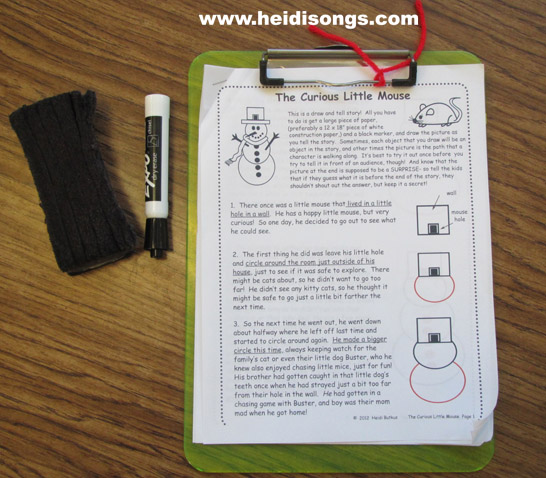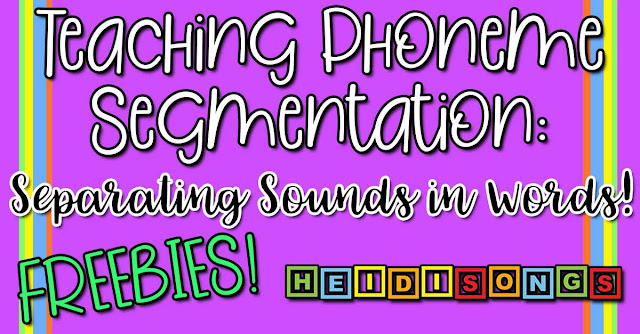Fitting It All In
Have you heard the news? We've Moved to HeidiSongs.tv!
Our new website features an online video streaming service, updated blog posts at Heidisongs.blog, and a wealth of fresh resources designed to make learning even more fun and engaging.
You can also continue shopping for our educational products there and at our Teachers Pay Teachers store!
Head over to HeidiSongs.tv now and explore all the exciting new features.
See you there!
__________________________________________________________________________
Every year, someone asks me how I manage to fit everything in, especially at the beginning of the year! And there is no doubt that it is quite challenging trying to establish those all important routines and procedures, while covering all of the songs, games, and activities that help get children started learning or reviewing the letters and sounds. And I guess that the short answer is that I can’t really do it all, any more than the rest of you can! But I have learned a few tricks to make things go a little bit faster, and I have learned to pick and choose which songs are the most important ones for my students to sing. Unfortunately, these may not always be my favorites (or theirs!).
I combine Zoo-Phonics and my Singable Songs for Letters and Sounds over the first four to six weeks or so of school. As far as both teaching and reviewing the songs, it seems to go faster using the DVD than the CD. The kids can sustain their attention to the activity about twice as long with the DVD as they can with the CD. I guess that makes sense, since they have the visual stimulation going in as well as the auditory. The "bells and whistles" on the screen are more interesting than "just me," I've discovered, even though I am exactly the same on the screen as I am in person! It's an interesting comparison, really! So this year, I am going to use the DVD even more than I did last year, and see if I can squeeze in even more in a short amount of time. Some teachers tell me that they would play the DVD for ten minutes a day, and then stop it. Then, they would pick up the next day at the same spot and then keep going for another ten minutes. When they got to the end of the DVD, they started it over again, and did this every day. I think that this model would work. The DVD lasts about 33 minutes, I think; so you will make it through the whole alphabet every three days if you do this. I would suggest skipping the Alphabet Action song and the Sounds to Letters song until your kids know most of the letters, though. I personally try to save the Alphabet Action song for review once they mostly know all of the letters and sounds. Otherwise, they would be too hard to follow and take too much time, because they are pretty long songs. Your students might lose attention due to the length of the songs, as well.
Last year, I introduced all of the songs, but spent more time reviewing and re-singing the songs for the more difficult to learn letters, like g, j, q, u, etc. It was necessary to pick and choose a little bit due to limited time, especially since our kids only attend half day for the first four weeks of school. After the first four weeks are up, our kids start staying until 1:20; then we are able to fit a lot more in.
There is an entry in my blog on how I combine Zoo-Phonics with my Alphabet CD at the beginning of the year, and it goes into much more detail. But the most important thing I have to say is that you will definitely have to pick and choose which songs/concepts your kids need the most, and make those your priority. Let yourself off the hook for the ones that you don't get to. Use the songs as transitional activities and use them as movement breaks or "brain breaks" as much as you can. I think that is my biggest "secret." We sit for a few minutes and read a book, and then stand up and sing a couple of songs. Then sit and listen to the directions for the art project or the math lesson, and then stand up and sing again, etc. They never sit for a very long time. I use the songs as a classroom management tool in this way, and they also do double duty as lesson reviews at the same time. Sometimes we sing on the way to lunch, etc. Needless to say, I'm usually physically exhausted by the end of the day! But it is a good, healthy way to spend your time, anyway! Just remember- every time your students appear restless, this is a good time to squeeze in another musical concept review with a song. So don’t waste that time! If you try to have them sit longer than they really are able to attend to, then they probably are not gaining much academically anyway.
I am including a pacing guide that I made up that includes the sight words, concepts, and general themes that my district requires. Each week, I staple the new words or letters, etc., that we are focusing on up next to my calendar. We call this our “Focus Wall.” It reminds me what I am supposed to be focusing on! This year, I got a little smarter and had my daughter sort the flashcards by week and paperclip them together with a post it note on the top that says which week they are for. That way, all I have to do is grab the cards for the following week and staple them up next to my calendar, and I am ready to go! I also chart out all of the art projects that we do each day on a little calendar, and try to fill them in as far as I can possibly go. Right now, I have the art projects for each day all planned out through the beginning of May! When each one is prepped and ready to go, I or my aide puts a little check mark in the corner of that calendar’s day so that I know we are all set.

It has also helped me to make a playlist on my ipod with the songs for each month on their own playlist in order. Last year, though, my September playlist soon became my “Fall Playlist,” since it grew a little too big! But I am going to fix it this year and hope it stays fixed from now on. You will also see in the farthest right hand column which “Singable Book” we are working on each week from my Printable Projects CD-Rom and the Little Songs for Language Arts CD and DVD. You may also notice some other titles on there that are not included in that set; those will be books or songs that I couldn’t publish because I did not create them and therefore do not own the copyright on them. But if anyone wants more information on any of the specific projects, just let me know and I will try to blog about them, or tell you where I purchased them.
All of this makes my planning and prep pretty quick and relatively easy! I also have my materials “mostly” filed away and sorted by skill. So, if we need to work on rhyming words, I go to my plastic chest of drawers that has my language arts materials in it, and look for the drawer marked “Rhyming Words.” Whenever I acquire or create something new to help kids work on rhyming words, it goes in there. That means that all I have to do is look on my pacing guide and see that I need to work on rhyming words, and then go to that drawer, and choose something from there. I LOVE it! (This works great until we wind up with a new “fabulous” reading program that we are all supposed to use faithfully, which requires hours of reading and digging in order to figure out what I am supposed to do. But that is another story....)
----------------------------------
Follow me! Did you enjoy this post? Do me a favor and share it with your friends! And follow this blog by signing up for my email updates here, or follow on Bloglovin', or follow me on TPT! I'm also on Pinterest, Facebook, Twitter, Instagram, Google+ and YouTube, too! Don't forget to sign up for our email newsletter for special deals and promo codes that you won't find out about anywhere else.











